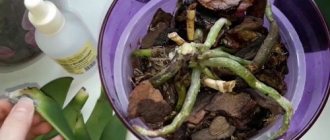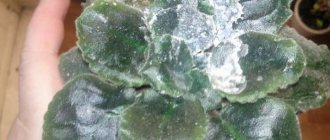Why do the leaves of the “female happiness” flower droop?
Wilting can be caused by the following reasons::
- unsuitable flowerpot;
- hypothermia;
- incorrect soil composition;
- insufficient or excessive watering;
- exceeding the norm of fertilizing;
- bacterial or fungal diseases;
- insect pests.
You can understand why a flower has drooping leaves by looking at the appearance of the plant.:
- If the leaves begin to turn yellow, become limp, and a dry crust appears on the surface of the soil, it means that the plant does not have enough moisture. In this case, the old leaves dry out, and the young ones lose their natural shine.
- Flabby foliage with dry tips indicates insufficient air humidity.
- The leaves may bend down and become dark green due to hypothermia (you can find out why spathiphyllum flowers and leaves darken here, and from this article you will learn what to do if the plant’s flowers turn black).
- The appearance of dark areas covered with a gray furry coating on the stems, leaf blades and soil is a sign of the development of a fungal infection.
- The leaves curl, droop and become covered with a thin web when the spathiphyllum is damaged by harmful insects.
Why have the leaves fallen?
It is unlikely that spathiphyllum can be classified as a whimsical or capricious plant. But it happens that during the growing process difficulties arise, mainly related to caring for indoor flowers. These problems are temporary and completely solvable. These include:
- unsuitable flowerpot;
- hypothermia;
- incorrect soil composition;
- incorrectly selected irrigation regime;
- low air humidity;
- fungal or bacterial infections;
- harmful insects.
What to do if there are drooping leaves?
If the spathiphyllum has dropped its leaves and does not raise them anymore, you need to identify the cause as quickly as possible and begin treatment.
For problems with roots
Drooping spathiphyllum leaves often indicate root rot, which occurs with abundant and frequent watering. If the plant is easily removed from the flowerpot, you need to take the following measures :
- The flower is carefully removed and the roots are examined. Damaged parts are removed with a sharp knife. The sections are treated with crushed activated carbon and dried for 3-4 hours.
- To destroy the fungus, the roots are treated with a fungicide:
- Maxim.
- Fitosporin.
- Topsin or Fundazol.
The drug, dissolved in water, is used immediately. Fitosporin is infused for 2 hours before use.
- The flower pot is cleaned and washed with a solution of potassium permanganate. Drainage is poured at the bottom, and light soil is placed on top.
- The plant is transplanted into the substrate, after slightly moistening it.
- The flower is watered for the first time after 2-3 days.
Improper watering
Spathiphyllum is considered a moisture-loving plant, but still it does not tolerate stagnant water . With abundant watering, the roots are constantly in wet soil, which provokes the development of fungal diseases (read more about how to treat spathiphyllum for leaf diseases here). Rotting of the root system affects the condition of the leaves. In this case, the plant is transplanted into a new substrate, after appropriate preparation and disinfection. In the future, the watering regime should be adjusted.
If a flower has wilted as a result of poor watering, it can be helped in this way:
- The pot with the plant is placed in a deep container half filled with water.
- The flower is left for 15-20 minutes so that the soil is completely wet.
- The leaves can be sprayed with warm water.
We invite you to watch an informative video about drooping leaves of spathiphyllum due to lack of watering:
Under improper conditions
Spathiphyllum feels good on a bright windowsill, shaded from the scorching rays of the sun. He does not like the cold and needs moist air. The following conditions are considered unfavorable :
To help drooping spathiphyllum, it is necessary to create a suitable microclimate:
- The optimal temperature in the warm season is +22…+23°С, and in the cold season – from +16°С.
- Indoor exotic does not grow well in a cramped pot because the roots do not have enough space for normal growth. The flower grows quickly and requires periodic replanting.
If aphids or spider mites are detected, do this:
- If there are few insects, it is enough to wipe the stems and leaves with a sponge dipped in a solution of laundry soap. To prepare the product you will need 150 g of grated bar and 5 liters of warm water.
- In case of numerous pests, the flower is sprayed with Actellik solution, covering the ground with a film. After a day, the plant is washed with clean water. If necessary, insecticide treatment is repeated.
If the soil is incorrectly selected
The cause of drooping leaves may be improper soil composition. Spathiphyllum is recommended to be planted in a light, loose and nutritious mixture. It is prepared from:
- peat bog;
- river sand;
- leaf soil;
- humus and charcoal.
The soil should allow water and air to pass well down to the roots . In a heavy, acidic environment, the plant develops poorly.
The soil must be suitable in all respects, otherwise it should be changed. A drainage layer with a height of at least 2 cm must be laid at the bottom of the flowerpot. Spathiphyllum can also wither due to excess nutrients. In this case, stop feeding so that the flower recovers and grows new foliage.
Transplantation: soil, choice of flower pot
Spathiphyllum leaves could begin to wither due to incorrectly chosen timing of transplantation. This operation is recommended to be carried out in early spring before flowering begins, or 2 weeks after it ends. Without inflorescences, the plant recovers faster.
The soil in an adult species is renewed every 3-4 years, in a young plant up to three years old - every year. If you do this more often, the foliage will begin to wilt.
The new soil should be dry, properly fertilized, and loose. Heavy acidic soil negatively affects the life of the flower.
A prerequisite is the presence of a drainage layer of pebbles or expanded clay at least 2 cm thick. It is needed to prevent water from stagnating in the lower part of the container. For the same purpose, medium-sized holes are made at the bottom of the flowerpot.
The incorrect composition of the soil mixture is replaced with a ready-made peat substrate. But it dries out quickly, and water does not reach the roots. In this case, the flower is removed from the pot and the roots are cleared of the peat layer. After three hours, the flower is transplanted.
The pot for transplanting spathiphyllum should be cramped, since the root system of this species is short and there is no stem.
Preventive measures
In order for spathiphyllum to develop well and not fade, you should adhere to these rules of care:
- The flower is planted in suitable soil and a flowerpot.
- It is better to place the plant on a windowsill on the west side, away from drafts and cold air.
- Transplantation is carried out at least once every 3 years.
- Watering should be regular and moderate.
- Fertilizing is systematically applied, adhering to the dosage.
- In hot weather, the flower is sprayed daily with warm water. It is recommended to place the pot on wet expanded clay. The air in the room can be humidified using a special device.
If spathiphyllum leaves wither, the cause should be identified and measures taken to eliminate it. If the roots rot, there is only one way out - urgent transplantation. The flower must be constantly monitored and promptly removed from diseases and parasites. Growing a beautiful and healthy bush is not difficult if you follow the rules of care.
Prevention
Having become familiar with why spathiphyllum leaves droop, after treatment it is necessary to adhere to the rules of care so as not to encounter such a problem again in the future. And repeated wilting can lead to a disastrous result, and the flower will die. Therefore, the plant should be provided with:
- necessary climatic conditions. The air temperature in summer should be maintained at +26 degrees, in winter – +16;
- maintain high humidity in the room with the flower;
- ensure regular watering and spraying;
- protect from direct sunlight and drafts;
- replant into suitable nutrient soil;
- systematically apply fertilizing;
- carry out disease prevention.
Proper care will prevent the appearance of causes that contribute to drooping leaves and ensure healthy flowering of the spathiphyllum.
We recommend watching a video about saving spathiphyllum:
Spathiphyllum has dropped its leaves - what to do
Spathiphyllum is traditionally considered a female flower that brings good luck in personal life - therefore it is often called “women’s happiness.” It is not surprising that at least one pot with this plant can be found in almost every apartment. I have it too, of course.
I took my copy from friends when their flower had grown too much and it was time to resettle it. It was only after the transplant that he suddenly began to wither. Although it is a very resilient plant, there are several reasons why spathiphyllum drops its leaves, and in this article I want to share my experience of what to do.
Features of further care
After transplantation, it is not difficult to care for spathiphyllum, but you need to be careful and follow the rules:
- Make sure the soil is moist, not wet.
- Spray the foliage every two to three days in winter and daily in summer with irrigation procedures.
- Do not allow direct sunlight to fall on the spathiphyllum. Make sure that in spring and summer the temperature does not exceed +26°C. In winter, it should not fall below +16°C.
Yellowing and wilting of the leaf blade is primarily a consequence of poor plant care. Correcting the situation is not easy, so it is always better to carefully monitor the condition of the flower and how the soil absorbs moisture. As soon as the first signs of a change in the color of the leaf plate are noticed, immediate action must be taken.
The main reasons why spathiphyllum drops its leaves
Spathiphyllum is unanimously considered unpretentious and easy to care for, but this does not mean that it does not require attention at all. Fortunately, this plant quickly signals if something is wrong with it - any problems immediately affect the color and tone of the foliage. Below I will tell you in more detail what signs to pay attention to and what they can mean.
Improper watering
Perhaps the most common reason for spathiphyllum wilting is errors in watering. Moreover, both excess water and its lack equally lead to unpleasant consequences. In both cases, the result may be root rot.
This problem is usually fairly easy to detect. If the spathiphyllum dropped its leaves a short time after abundant watering, there was too much water. In the early stages, it is enough to loosen the soil and let it dry thoroughly.
The consequences of a lack of fluid begin after 1.5-2 weeks of thirst. By this time, the earth completely dries out and cracks. In this situation, “bottom” watering will help, when the pot is placed in a container of water for 30-40 minutes. This method allows you to wet the soil evenly and exactly as much as necessary.
In advanced cases, when the problem has already affected the health of the root system, the leaves begin to turn yellow en masse, lose their elasticity and quickly wither. After watering, the soil remains wet for a long time because the plant is unable to absorb it.
You can also carefully pull the spathiphyllum out of the pot - if it comes out easily, it is unlikely to be saved. In other cases, you need to follow the algorithm:
- Carefully remove the flower, rinse the underground part under warm water;
- Carefully inspect and cut off with a sharp knife or scissors all dry, on the contrary, softened or otherwise damaged roots;
- Treat sections with crushed activated carbon to avoid infection. You can also spray with fungicides, since during this period the plant is especially defenseless against fungal infections;
- Replant in new dry soil with a good drainage layer at the bottom of the pot.
At first it is better to refrain from watering, and then adhere to a rational regime. Spathiphyllum is moisture-loving, but under no circumstances should the water stagnate.
Conditions of detention
Spathiphyllum is a tropical plant and prefers a warm and humid climate, so it reacts sharply to hypothermia and dry air. It is worth paying attention to the following symptoms:
- In the first case, in addition to the fact that the flower has dropped its leaves, it will also change color to a darker one.
- You will recognize the second option by the drying ends.
The problem can be solved simply - you need to change the conditions of maintenance: move the flower away from drafts and spray it regularly. If it starts to rise, then these measures are enough. But if the condition does not improve, it is worth looking for additional reasons.
Also remember that at lower temperatures, water absorbs and dries much more slowly. In the cold, indoor plants, especially those imported from hot countries, are more susceptible to root rot. What to do if the roots are damaged is described in the previous section.
Priming
If the reasons mentioned above do not apply, you should also pay attention to the pot and the soil in it. For good health, spathiphyllum needs a close “house” and light soil, well-permeable to air and with a thick drainage layer.
If the container is too spacious, the spathiphyllum drops its leaves and does not bloom, although it does not wither. It is enough to transfer it into a more suitable pot to invigorate it. Young plants are usually replanted once a year.
But they try to move mature flowers as rarely as possible, because for them the procedure is very stressful. Even under favorable conditions, after changing the pot, spathiphyllum drops its leaves and “mopes” for some time.
Usually people think about replanting if Women's Happiness has become too prolific and the soil has become salty and compacted. At the same time, the water begins to stagnate, which can damage the roots.
By the way, the danger is posed not only by poor soil, devoid of nutrients, but also by excess fertilizer. Therefore, in order for your home plant to delight you with healthy and strong foliage, you need to observe moderation in everything: both in fertilizing and in watering.
For additional tips on caring for spathiphyllum, especially after transplantation, you can watch the video:
Eliminating causes at home
There are a large number of reasons why leaves or any other part of the spathiphyllum begins to turn yellow and fade. Below we will analyze in detail the most common of them.
Improper watering
The main symptom is yellowing of the edges of the leaves and further drying out when there is a maximum lack of moisture in the substrate. The earthen ball begins to dry out, and so do the roots, which is why the edge of the leaf blade turns brown. It is urgent to water the plant and spray it.
This can also happen due to the accumulation of moisture in the soil, and to solve the problem you need to do the following:
- Remove the earthen lump from the pot.
- Rinse it with running water, thereby getting rid of excess soil.
- Inspect the roots for the presence of rot, which appears when there is excess moisture (healthy ones are white, while infected ones are yellowish).
- Remove affected roots using a sharp knife.
- Sprinkle the cut areas with activated carbon and leave the healthy rhizome to dry for 2 - 3 hours.
- Plant spathiphyllum in a new substrate, but there is no need to water immediately after planting.
- Water after 2–3 days with warm, settled water.
Improper care
- When direct sunlight hits the spathiphyllum, yellow spots appear on its leaves, which then turn brown, dry out and crumble (why do the leaves change color, turn black and dry out?). It is necessary to move the flower pot to western or eastern windows, where the light is scattered (read more about the reasons for the appearance of brown or other colored spots on spathiphyllum leaves here).
- Too low a temperature, even with normal watering, can lead to rotting of the roots and therefore yellowing of the leaves. The plant is especially vulnerable to this problem in winter. You need to move the plant as far as possible from the cold windowsill or use high trays so that the bottom of the pot does not cool to dangerously low temperatures.
- Insufficient humidity level. To avoid yellowing of spathiphyllum due to this reason, you need to spray it daily during the growing season, you can also use a pot with expanded clay (this was discussed above).
To find out what exactly is the matter, you need to eliminate the reasons one by one.
Lack of essential microelements
In another way it can be called chlorosis. You can recognize this reason by a characteristic feature: the yellowing of the leaves of the plant occurs unevenly. For example, the veins may be green, but the leaf blade may be yellow. Small yellow spots may appear scattered throughout the plant in a chaotic manner.
In most cases, the plant lacks boron, iron and calcium. You can prevent further yellowing of spathiphyllum with the help of properly selected fertilizers (to be sure you don’t make a mistake, you can use complex ones).
Diseases
Fungal diseases manifest themselves by drying out and the subsequent appearance of brown spots, which quickly spread not only over the leaves of the spathiphyllum, but also to neighboring plants as well.
- Cut off infected spathiphyllum leaves.
- Remove the rhizome from the pot.
- Rinse it with warm water.
- Inspect for damage and remove it by cutting it off.
- Treat the plant with fungicides.
- Wash the pot with soap and rinse with boiling water.
- Replant the plant in new soil.
Read in detail about the main diseases of spathiphyllum here, and we talked about how to treat a plant with leaf diseases in a separate article.
Pests
Most often, spathiphyllum is attacked by pests such as mealybugs, thrips, and spider mites. You need to get rid of them as follows:
- Treat spathiphyllum with an insecticidal preparation.
- If there are pests in the soil, replant the plant after pre-treating the roots and container according to the algorithm described above.
Why is this happening
There are several reasons why spathiphyllum dropped its leaves. It could be:
- improper watering. Leaves may droop due to dry soil or overwatering;
- excess fertilizer;
- sudden temperature changes and changes in the conditions of keeping the flower;
- Leaves may droop after transplantation. The plant needs some time to get used to the new conditions. During this period, there is no need to feed it or water it abundantly;
- pests Can lead to the death of the flower.
If signs of the disease are detected, it is necessary to find out as quickly as possible the reasons why the foliage has withered and start treating spathiphyllum.
How to determine the disease
There are several symptoms that indicate that the plant is sick. First of all, this is the appearance of dark spots, black or dark brown, on the leaves. Yellowed or excessively light plates are a signal that the flower is sick. But this sign may also indicate a violation of the conditions of detention.
The appearance of black spots on the leaf plate is a sign that “female happiness” is sick
Other symptoms indicating spathiphyllum disease:
- Lack of flowering.
- Darkening of the leaf blades is a sign that the roots have rotted due to excessive watering.
- Dryness of leaves along the edges, curling.
- Stems and leaf blades begin to turn black and curl for no apparent reason.
What to do when spathiphyllum foliage drops
If the leaves of a Woman's Happiness have drooped, first of all, you need to find out the reasons why this happened to him and take the necessary measures to save him.
Most often, the foliage fades if the flower is not watered for 1-1.5 weeks. In this case, the plant should be watered with half the amount of water used for regular watering. Then cover the flower with a plastic bag to retain moisture longer. After 1-2 days, repeat the procedure. This helps restore roots and prevent wilting and yellowing of the foliage.
It is worth remembering that excessive watering can also cause drooping leaves. Sometimes stagnation of water can even lead to the death of a plant. To help the flower, remove excess moisture using paper napkins. If the soil has been wet for a long time and the roots have begun to rot, as indicated by blackening of the leaves, the spathiphyllum needs to be replanted. To do this you need:
- remove the spathiphyllum from the pot;
- check the roots for rotting and damage;
- remove affected parts;
- dry well;
- transplant the plant into a new pot with fresh soil;
- stabilize the watering process.
Another factor contributing to why the leaves of Women's Happiness droop is the dry air in the room with the flower. To solve the problem, you need to spray the plant twice a day. You can place a container filled with water next to the spathiphyllum or turn on a humidifier in the room.
Often the foliage may droop if Women's Happiness is freezing. In this case, you should check the root system. If there are healthy roots, the plant must be replanted, the missing roots removed, and placed in a place with suitable climatic conditions. If the roots are completely gone, it will not be possible to save the flower.
If the spathiphyllum has dropped its leaves due to excess nutrients, it is worth stopping feeding until the flower recovers and grows fresh foliage.
Incorrectly selected soil can also cause drooping leaves. The soil should be light, loose, well-drained and capable of allowing air and moisture to pass down to the very tips of the roots. If it does not meet the requirements, the flower must be transplanted into fresh nutritious soil.
Spathiphyllum's leaves have dropped
Spathiphyllum is a perennial houseplant. Florists are attracted by its rich green leaves and unusual flowers that resemble white sails.
Spathiphyllum is unpretentious, but sometimes its leaves suddenly droop. To save your favorite flower, you need to know the causes of this problem and how to eliminate them. The article below is devoted to this topic.
Why do the leaves of the “female happiness” flower droop?
Wilting can be caused by the following reasons::
- unsuitable flowerpot;
- hypothermia;
- incorrect soil composition;
- insufficient or excessive watering;
- exceeding the norm of fertilizing;
- bacterial or fungal diseases;
- insect pests.
You can understand why a flower has drooping leaves by looking at the appearance of the plant.:
- If the leaves begin to turn yellow, become limp, and a dry crust appears on the surface of the soil, it means that the plant does not have enough moisture. In this case, the old leaves dry out, and the young ones lose their natural shine.
- Flabby foliage with dry tips indicates insufficient air humidity.
- The leaves may bend down and become dark green due to hypothermia (you can find out why spathiphyllum flowers and leaves darken here, and from this article you will learn what to do if the plant’s flowers turn black).
- The appearance of dark areas covered with a gray furry coating on the stems, leaf blades and soil is a sign of the development of a fungal infection.
- The leaves curl, droop and become covered with a thin web when the spathiphyllum is damaged by harmful insects.
What is the threat?
There are many reasons for the wilting of spathiphyllum, but most of them are easily removable. It is important to detect the disease as early as possible . In advanced cases, when the roots rot, most often the plant cannot be saved. The leaves gradually dry out and fall off, and the roots die off (read more about why spathiphyllum can die and how to save the plant here).
What to do if there are drooping leaves?
If the spathiphyllum has dropped its leaves and does not raise them anymore, you need to identify the cause as quickly as possible and begin treatment.
For problems with roots
Drooping spathiphyllum leaves often indicate root rot, which occurs with abundant and frequent watering. If the plant is easily removed from the flowerpot, you need to take the following measures :
- The flower is carefully removed and the roots are examined. Damaged parts are removed with a sharp knife. The sections are treated with crushed activated carbon and dried for 3-4 hours.
- To destroy the fungus, the roots are treated with a fungicide:
- Maxim.
- Fitosporin.
- Topsin or Fundazol.
The drug, dissolved in water, is used immediately. Fitosporin is infused for 2 hours before use.
- The flower pot is cleaned and washed with a solution of potassium permanganate. Drainage is poured at the bottom, and light soil is placed on top.
- The plant is transplanted into the substrate, after slightly moistening it.
- The flower is watered for the first time after 2-3 days.
Improper watering
Spathiphyllum is considered a moisture-loving plant, but still it does not tolerate stagnant water..
With abundant watering, the roots are constantly in wet soil, which provokes the development of fungal diseases (read more about how to treat spathiphyllum for leaf diseases here). Rotting of the root system affects the condition of the leaves.
In this case, the plant is transplanted into a new substrate, after appropriate preparation and disinfection. In the future, the watering regime should be adjusted.
If a flower has wilted as a result of poor watering, it can be helped in this way:
- The pot with the plant is placed in a deep container half filled with water.
- The flower is left for 15-20 minutes so that the soil is completely wet.
- The leaves can be sprayed with warm water.
We invite you to watch an informative video about drooping leaves of spathiphyllum due to lack of watering:
Under improper conditions
Spathiphyllum feels good on a bright windowsill, shaded from the scorching rays of the sun. He does not like the cold and needs moist air. The following conditions are considered unfavorable :
To help drooping spathiphyllum, it is necessary to create a suitable microclimate:
- The optimal temperature in the warm season is +22…+23°С, and in the cold season – from +16°С.
- Indoor exotic does not grow well in a cramped pot because the roots do not have enough space for normal growth. The flower grows quickly and requires periodic replanting.
Source: https://mahnem-ru.ru/u-spatifilluma-opustilis-listja/
The reason is diseases
At times, the leaves of Women's Happiness fall not because of improper care, but because of illness.
- If the spathiphyllum not only droops its foliage, but also loses its brightness, this indicates the presence of root rot. If a disease is detected, the root system must be treated with a fungicide and transplanted into fresh, disinfected soil.
- Another disease that contributes to the wilting of foliage, in which its edges turn black, is gommosis. In this case, you should get rid of all damaged leaves. Wash the plant with soapy water and rinse well with warm water.
- Wilting leaves can cause aphids to appear. To get rid of it, spathiphyllum should be treated with a light solution of manganese or insecticides. Carry out the procedure twice a week.
When Women's Happiness is Reanimated
If you notice that the plant is withering, it is really important to know how to revive it in this case. Measures to resuscitate it are carried out if previous actions did not cause the desired effect, therefore, the condition of the flower not only did not improve, but also became noticeably narrower. A flower that needs urgent resuscitation has the following appearance:
A flower that needs urgent resuscitation has the following appearance:
- blackened leaves;
- leaf blade that has lost turgor;
- the roots of the plant are light in color and dry to the touch;
- in the tissues of the flower one can observe the appearance of fungal spores in different parts of the flower;
- the flowering period does not begin;
- the crown of young shoots is dark in color;
- the foliage is yellow, dry and limp;
- the plant has stopped growing;
- the root system is black, and its shoots are empty to the touch.
Damage to all foliage
If all the leaves of a spathiphyllum droop and begin to wither at the same time, it means that the root system has rotted. This mainly happens if the flower is not watered for a long time. The roots have nowhere to get moisture and nutrients, and they begin to rot. The solution to this problem is replanting, provided there are healthy areas of the root system remaining. To transplant a flower you need:
- carefully remove Women's Happiness from the pot;
- inspect the roots, cut them down to living tissue and treat them with powdered activated carbon;
- dry well for 3-4 hours;
- Fresh, light soil is poured into the new pot. It can be made by mixing peat bog, coarse sand, leaf soil, humus and charcoal;
- You can use an old container, but clean it well and disinfect it. To avoid rotting of the cut sites, it is recommended to add a tablet of activated carbon to the soil;
- Check for holes in the bottom of the pot. If there are none, do it;
- lay out a drainage layer;
- replant the plant after slightly moistening the soil;
- The first watering should be done after 2-3 days.
Why do spathiphyllum leaves wither, and what to do about it?
Most often, the reasons for the change in color of spathiphyllum foliage lie in non-compliance with the rules of caring for it.
Did you know? It is popularly believed that spathiphyllum scares away uninvited guests, which is why it is also called the “house spirit.”
The land is overdried
Rare or insufficient watering leads to the soil becoming dry. It is difficult for the flower to obtain the elements it needs, and there is also an acute lack of moisture. Because of this, the leaves first lose their elasticity and then turn yellow. The earth is covered with a dry crust. It is dangerous to water such a flower suddenly.
First you need to water with half the usual amount of moisture. After the procedure, the flower must be covered with a transparent bag. The next irrigation procedure is carried out a day or two later using the same amount of water.
Heterogeneous soil
Heterogeneity or poor quality of soil leads to a deficiency of nutrients. This leads to drying out of the foliage. You need to replant the plant by filling the pot with a light nutrient mixture with a drainage layer.
Root rotting
Blackening of the tip of the spathiphyllum leaf blade indicates soaking of the roots and the beginning of putrefactive processes. In this case, the flower must be urgently saved, otherwise it will die. The salvation will be replanting into a new pot with fresh soil. Before planting, the root system must be inspected, affected roots must be removed, and the rest must be treated with activated carbon.
Did you know? It is useful to keep spathiphyllum in houses where renovations are actively underway, since the flower absorbs vapors of benzene, acetone, ammonia and other chemicals.
Improper watering
Even if spathiphyllum is watered, its foliage may still turn yellow. The reason may be that watering is not systematic (rare or very frequent), cold and hard water is used. It is also detrimental to the plant if excess water remains in the pan after watering. If the leaves are yellowed, but not blackened, and the soil is moist, then most likely watering was frequent, so you need to get rid of excess moisture.
To do this, you need to lay out paper napkins on the surface of the soil, on the leaves, and under the bottom of the flowerpot. When they are saturated with moisture, remove them and lay out new ones. The steps are repeated until the napkins remain dry.
Hypothermia
If the spathiphyllum is left in a draft for a long time, in a cold room, or if there is water left in the tray and the window sill is cold, the leaves begin to turn black at the tips. Moreover, blackness often appears on very young leaves that have not had time to open. Old leaves may droop. Such a flower needs to be removed from the soil and the roots examined. If they are alive, treat with Elin and plant in new soil.
Important! If the root system of a flower has died due to the cold, it is thrown away as it cannot be restored.
Incorrect plant replanting
Poor quality or unsuitable soil, or a flowerpot of the wrong size, can cause the “female happiness” to begin to turn yellow after transplantation. The soil should be air- and water-permeable, and a layer of drainage should be placed underneath it. The pot is chosen commensurate with the size of the flower. If after transplanting you are not sure whether the soil is suitable, water it and see how it absorbs moisture.
If it’s bad, change the soil to looser, lighter soil with minerals. After changing the pot, do not overwater the flower. It’s better to treat it with Zircon. It will help you quickly adapt to a new place. If you don’t have the drug on hand, you can cover the pot with “women’s happiness” with a transparent bag and leave it like that for a couple of days.











